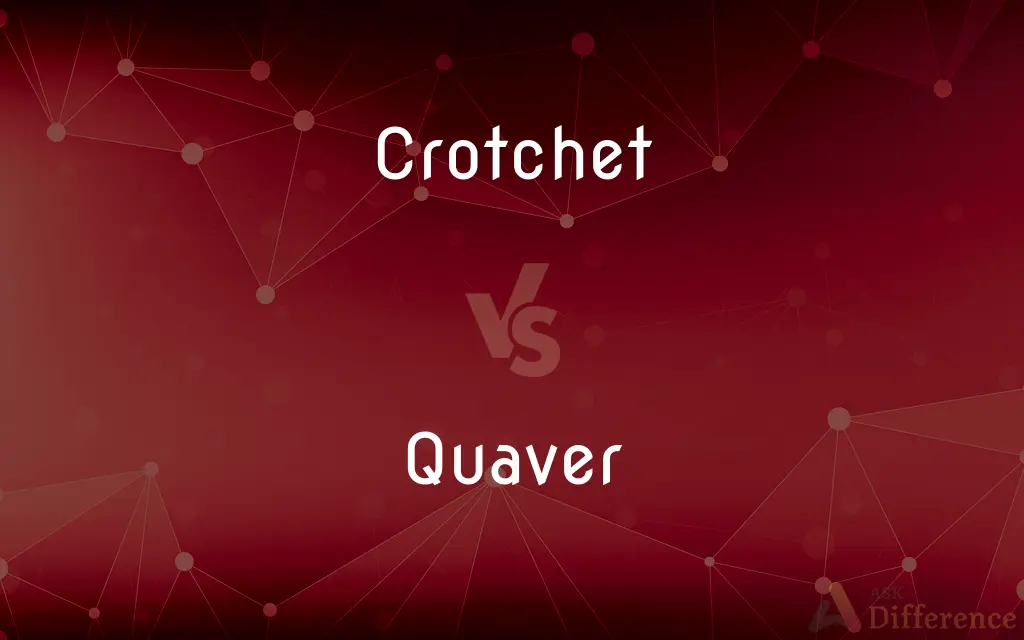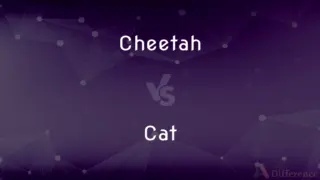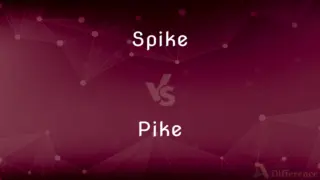Crotchet vs. Quaver — What's the Difference?
Edited by Tayyaba Rehman — By Maham Liaqat — Updated on April 15, 2024
A crotchet is a musical note with a duration of one beat in 4/4 time, whereas a quaver lasts half a beat.

Difference Between Crotchet and Quaver
Table of Contents
ADVERTISEMENT
Key Differences
A crotchet, known as a quarter note in American English, holds a beat in common time (4/4), making it fundamental for steady rhythms. On the other hand, a quaver, or eighth note, is half as long, introducing more pace and rhythm complexity.
In sheet music, a crotchet is represented by a filled-in note head with a straight stem, serving as a rhythmic anchor in many compositions. Whereas, a quaver appears with the same filled-in head but also includes a tail or flag, indicating its quicker passage.
When grouping, crotchets are typically written individually or connected by beams in more complex rhythmic structures. Quavers, in contrast, are often connected in groups of two or more, facilitating quicker rhythmic reading and execution.
In terms of tempo, a crotchet's duration becomes shorter as the tempo increases, yet it remains a consistent rhythmic unit. Quavers, being shorter, adapt to fast tempos, allowing for lively and intricate musical phrases.
Musicians often use crotchets to maintain a steady and stable rhythm within a piece, providing a sense of order and predictability. Quavers, however, are utilized to enhance the melody with their briskness, offering nuances and excitement.
ADVERTISEMENT
Comparison Chart
Duration
One beat in 4/4 time
Half a beat in 4/4 time
Symbol
Filled note head with a straight stem
Filled note head with a stem and a flag
Grouping
Written individually or connected by beams
Often connected in groups with beams
Role in Rhythm
Provides steady rhythm and anchors tempo
Adds complexity and pace to the rhythm
Adaptability in Tempo
Shortens with faster tempos but remains consistent
Very adaptable, enhances fast, intricate passages
Compare with Definitions
Crotchet
The stem of a crotchet can point upwards or downwards depending on its position on the staff.
The crotchets in the lower staff had downward-pointing stems.
Quaver
The presence of a flag distinguishes quavers from crotchets on musical notation.
Each quaver in the score was marked with a single flag.
Crotchet
Crotchets are often used to outline the basic rhythm in beginner music pieces.
The piano lesson focused on playing crotchets steadily.
Quaver
Quavers are crucial for creating faster, more complex musical patterns.
The violin part was full of rapid quaver movements.
Crotchet
A crotchet is a musical note lasting one beat in a 4/4 time signature.
In a simple drum beat, each crotchet corresponds to one foot tap.
Quaver
Quavers add rhythmic diversity and can be beamed together in compositions.
The composer used beamed quavers to create a lively section.
Crotchet
In marching bands, crotchets dictate the fundamental marching tempo.
Each step of the march aligned with a crotchet beat.
Quaver
In jazz, quavers are often swung, altering their traditional rhythmic feel.
The saxophone solo used swung quavers for a groovy effect.
Crotchet
Crotchets can be modified with dots to increase their duration.
A dotted crotchet lasts one and a half beats.
Quaver
A quaver is a musical note that lasts half a beat in a 4/4 time signature.
The flutist played a series of quick quavers.
Crotchet
An odd, whimsical, or stubborn notion.
Quaver
To quiver, as from weakness; tremble.
Crotchet
(Music) See quarter note.
Quaver
To speak in a quivering voice; utter a quivering sound.
Crotchet
A small hook or hooklike structure.
Quaver
(Music) To produce a trill on an instrument or with the voice.
Crotchet
(music) A musical note one beat long in 4/4 time.
Quaver
To utter or sing in a trilling voice.
Crotchet
(obsolete) A sharp curve or crook; a shape resembling a hook
Quaver
A quivering sound.
Crotchet
A hook-shaped instrument, especially as used in obstetric surgery.
Quaver
A trill.
Crotchet
(archaic) A whim or a fancy.
Quaver
An eighth note.
Crotchet
A forked support; a crotch.
Quaver
A trembling shake.
Crotchet
An indentation in the glacis of the covered way, at a point where a traverse is placed.
Quaver
A trembling of the voice, as in speaking or singing.
Crotchet
(military) The arrangement of a body of troops, either forward or rearward, so as to form a line nearly perpendicular to the general line of battle.
Quaver
(music) an eighth note, drawn as a crotchet (quarter note) with a tail.
Crotchet
(printing) A square bracket.
Quaver
To shake in a trembling manner.
Crotchet
(obsolete) to play music in measured time
Quaver
(intransitive) To use the voice in a trembling manner, as in speaking or singing.
Crotchet
Archaic form of crochet
Quaver
(transitive) To utter quaveringly.
Crotchet
A forked support; a crotch.
The crotchets of their cot in columns rise.
Quaver
To tremble; to vibrate; to shake.
Crotchet
A time note, with a stem, having one fourth the value of a semibreve, one half that of a minim, and twice that of a quaver; a quarter note.
Quaver
Especially, to shake the voice; to utter or form sound with rapid or tremulous vibrations, as in singing; also, to trill on a musical instrument
Crotchet
An indentation in the glacis of the covered way, at a point where a traverse is placed.
Quaver
To utter with quavers.
We shall hear her quavering them . . . to some sprightly airs of the opera.
Crotchet
The arrangement of a body of troops, either forward or rearward, so as to form a line nearly perpendicular to the general line of battle.
Quaver
A shake, or rapid and tremulous vibration, of the voice, or of an instrument of music.
Crotchet
A bracket. See Bracket.
Quaver
An eighth note. See Eighth.
Crotchet
An instrument of a hooked form, used in certain cases in the extraction of a fetus.
Quaver
A tremulous sound
Crotchet
A perverse fancy; a whim which takes possession of the mind; a conceit.
He ruined himself and all that trusted in him by crotchets that he could never explain to any rational man.
Quaver
A musical note having the time value of an eighth of a whole note
Crotchet
To play music in measured time.
Quaver
Give off unsteady sounds, alternating in amplitude or frequency
Crotchet
A sharp curve or crook; a shape resembling a hook
Quaver
Sing or play with trills, alternating with the half note above or below
Crotchet
A musical note having the time value of a quarter of a whole note
Crotchet
A strange attitude or habit
Crotchet
A small tool or hook-like implement
Common Curiosities
What is the difference in appearance between a crotchet and a quaver?
The main difference is that a crotchet has a straight stem, while a quaver has a stem with one flag attached, indicating its shorter duration.
Can crotchets and quavers be combined in a musical piece?
Yes, crotchets and quavers can be combined in a musical piece to create varied rhythmic patterns, often contributing to a more interesting and textured rhythmic feel.
Why are quavers often beamed together in music?
Quavers are often beamed together to indicate that they are part of the same rhythmic grouping, which helps performers read and execute the music more fluidly.
How do dynamics affect the playing of crotchets and quavers?
Dynamics can affect how crotchets and quavers are played, with louder dynamics often giving these notes a more pronounced and impactful presence in the music.
How do quavers enhance musical compositions?
Quavers enhance musical compositions by adding complexity and allowing for faster, more rhythmic variations, which contribute to the overall dynamism of the piece.
How do crotchets contribute to musical rhythm?
Crotchets contribute to musical rhythm by providing a steady pulse, making them a core element in maintaining the basic timing within a piece.
What role do crotchets play in teaching music?
Crotchets are fundamental in teaching music as they represent the basic unit of time in many musical pieces, helping beginners learn timing and rhythm.
In what types of music are quavers most frequently used?
Quavers are frequently used in types of music that require quick, lively rhythms such as jazz, classical virtuoso pieces, and much of contemporary pop and rock music.
Are there any other musical notes related to crotchets and quavers?
Yes, related notes include the semiquaver, which is half the duration of a quaver, and the minim, which is twice the duration of a crotchet.
Can crotchets or quavers be modified with dots? What does this signify?
Both crotchets and quavers can be modified with dots after the note head, which extends the duration by half of the note's original value, adding more flexibility to rhythm creation.
How does the tempo of a piece affect the duration of a crotchet and a quaver?
The tempo of a piece directly affects the duration; as the tempo increases, both crotchets and quavers are played more quickly, though their relative duration to each other remains the same.
How do musicians count crotchets and quavers in different time signatures?
Musicians count crotchets as one beat in most time signatures, while quavers are counted as half a beat, though the actual counting can vary based on the specific time signature (e.g., 3/4, 6/8).
What is the historical origin of the terms 'crotchet' and 'quaver'?
The term 'crotchet' comes from the Old French 'crochet', meaning little hook, which refers to the note's hook-like stem. 'Quaver' originates from the 16th-century Middle English word 'quaveren', meaning to tremble, reflecting the note's rapid movement.
What is the challenge in playing sequences of rapid quavers?
Playing rapid quaver sequences can be challenging due to the need for precise timing and finger dexterity, especially in fast tempos or complex rhythmic contexts.
How do different instruments handle the playing of crotchets and quavers?
Different instruments handle these notes based on their inherent characteristics; for example, percussive instruments like drums might emphasize the rhythmic aspect, while melodic instruments like violins focus on the tonal and dynamic changes.
Share Your Discovery

Previous Comparison
Cheetah vs. Cat
Next Comparison
Spike vs. PikeAuthor Spotlight
Written by
Maham LiaqatEdited by
Tayyaba RehmanTayyaba Rehman is a distinguished writer, currently serving as a primary contributor to askdifference.com. As a researcher in semantics and etymology, Tayyaba's passion for the complexity of languages and their distinctions has found a perfect home on the platform. Tayyaba delves into the intricacies of language, distinguishing between commonly confused words and phrases, thereby providing clarity for readers worldwide.
















































